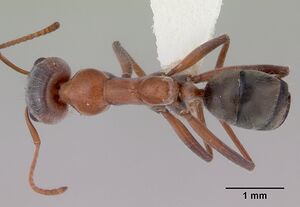Iridomyrmex cappoinclinus
| Iridomyrmex cappoinclinus | |
|---|---|

| |
| Scientific classification | |
| Kingdom: | Animalia |
| Phylum: | Arthropoda |
| Class: | Insecta |
| Order: | Hymenoptera |
| Family: | Formicidae |
| Subfamily: | Dolichoderinae |
| Tribe: | Leptomyrmecini |
| Genus: | Iridomyrmex |
| Species: | I. cappoinclinus |
| Binomial name | |
| Iridomyrmex cappoinclinus Shattuck, 1993 | |
The species has been collected in arid areas. The nest from which the type series was taken was in a low sand dune vegetated by Triodia and Acacia, and consisted of a single entrance in a slight depression. Two other nest collections have also been made, in each case in a sandy area vegetated by Triodia on one instance and by Acacia on the other occasion (see Shattuck, 1993b).
Identification
Iridomyrmex cappoinclinus differs from other members of the I. rufoinclinus complex in its colour pattern; namely, mesosoma generally yellowish to reddish, but with a reddish-brown to blackish frons.
Keys including this Species
Distribution
Latitudinal Distribution Pattern
Latitudinal Range: -23.10944366° to -26.28333333°.
| North Temperate |
North Subtropical |
Tropical | South Subtropical |
South Temperate |
- Source: AntMaps
Distribution based on Regional Taxon Lists
Australasian Region: Australia (type locality).
Distribution based on AntMaps
Distribution based on AntWeb specimens
Check data from AntWeb
Countries Occupied
| Number of countries occupied by this species based on AntWiki Regional Taxon Lists. In general, fewer countries occupied indicates a narrower range, while more countries indicates a more widespread species. |

|
Estimated Abundance
| Relative abundance based on number of AntMaps records per species (this species within the purple bar). Fewer records (to the left) indicates a less abundant/encountered species while more records (to the right) indicates more abundant/encountered species. |

|
Biology
Castes
Worker
Images from AntWeb
   
| |
| Holotype of Iridomyrmex cappoinclinus. Worker. Specimen code casent0172058. Photographer April Nobile, uploaded by California Academy of Sciences. | Owned by ANIC, Canberra, Australia. |
Nomenclature
The following information is derived from Barry Bolton's Online Catalogue of the Ants of the World.
- cappoinclinus. Iridomyrmex cappoinclinus Shattuck, 1993b: 1315, figs. 30, 31, 37 (w.) AUSTRALIA. See also: Heterick & Shattuck, 2011: 57.
Type Material
- Holotype, worker, 73km S Alice Springs, Northern Territory, Australia, 24°15′0″S 133°26′0″E / 24.25°S 133.433333°E, ANIC32-000052, Australian National Insect Collection.
- Paratype, 12 workers, 73km S Alice Springs, Northern Territory, Australia, 24°15′0″S 133°26′0″E / 24.25°S 133.433333°E, ANIC32-000053, Australian National Insect Collection.
- Paratype, 3 workers, 73km S Alice Springs, Northern Territory, Australia, 24°15′0″S 133°26′0″E / 24.25°S 133.433333°E, The Natural History Museum.
- Paratype, 3 workers, 73km S Alice Springs, Northern Territory, Australia, 24°15′0″S 133°26′0″E / 24.25°S 133.433333°E, Museum of Comparative Zoology.
- Paratype, 3 workers, 73km S Alice Springs, Northern Territory, Australia, 24°15′0″S 133°26′0″E / 24.25°S 133.433333°E, Tropical Ecology Research Centre.
Description
Worker Description. Head. Posterior margin of head planar to weakly concave; erect setae on posterior margin in full-face view set in a row; sides of head noticeably convex; erect genal setae present on sides of head in full- face view. Ocelli absent; in full-face view, eyes set at about midpoint of head capsule; in profile, eye set anteriad of head capsule; eye semi-circular. Frontal carinae concave; antennal scape surpassing posterior margin of head by 1- 2 x its diameter. Erect setae on scape absent, except at tip; prominence on anteromedial clypeal margin present as an indistinct swelling or undulation; mandible regularly triangular with oblique basal margin; long, curved setae on venter of head capsule present. Mesosoma. Pronotum weakly undulant or almost straight. Erect pronotal setae numerous (12 or more) and longest setae elongate, flexuous and/or curved. Mesonotum sinuous. Erect mesonotal setae numerous (12 or more) and elongate, flexuous and/or curved. Mesothoracic spiracles always prominent as small, vertical protuberances; propodeal dorsum smoothly and evenly convex; placement of propodeal spiracle mesad, more than its diameter away from propodeal declivity; propodeal angle weakly present or absent, the confluence of the dorsal and declivitous propodeal faces indicated, if at all, by an undulation. Erect propodeal setae numerous (12 or more) and elongate, flexuous and/or curved. Petiole. Dorsum of node convex, or planar; node thick, orientated anteriad. Gaster. Non-marginal erect setae of gaster present on first gastral tergite; marginal erect setae of gaster present on first tergite. General characters. Allometric differences between workers of same nest absent. Colour frons of head, coxae and gaster dark brown to blackish, other body parts brick-red. Colour of erect setae pale brown.
Measurements. Worker (n = 7)—CI 93–97; EI 25–27; EL 0.31–0.33; EW 0.18–0.20; HL 1.26–1.36; HW 1.21–1.30; ML 0.58–0.65; PpH 0.17–0.21; PpL 0.75–0.78; SI 87–90; SL 1.07–1.14.
References
- Heterick, B.E. & Shattuck, S.O. 2011. Revision of the ant genus Iridomyrmex (Hymenoptera: Formicidae). Zootaxa 2845: 1-175.
- Heterick, B.E. 2021. A guide to the ants of Western Australia. Part I: Systematics. Records of the Western Australian Museum, Supplement 86, 1-245 (doi:10.18195/issn.0313-122x.86.2021.001-245).
- Heterick, B.E. 2022. A guide to the ants of Western Australia. Part II: Distribution and biology. Records of the Western Australian Museum, supplement 86: 247-510 (doi:10.18195/issn.0313-122x.86.2022.247-510).
- Shattuck, S.O. 1993b. Revision of the Iridomyrmex calvus species-group (Hymenoptera: Formicidae). Invertebr. Taxon. 7: 1303-1325.
References based on Global Ant Biodiversity Informatics
- Heterick B. E., and S. Shattuck. 2011. Revision of the ant genus Iridomyrmex (Hymenoptera: Formicidae). Zootaxa 2845: 1-174.
- Shattuck S. O. 1993. Revision of the Iridomyrmex calvus species-group (Hymenoptera: Formicidae). Invertebrate Taxonomy 7: 1303-1325.

